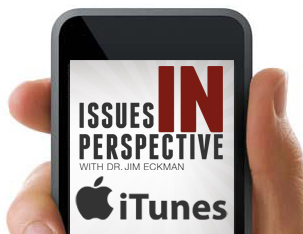America’s Credit Rating, Its Debt And The Coming Crisis
Jun 28th, 2025 | By Dr. Jim Eckman | Category: Featured Issues, Politics & Current EventsThe mission of Issues in Perspective is to provide thoughtful, historical and biblically-centered perspectives on current ethical and cultural issues.

It has been a long time in coming and there have been warning signs for years, but the American debt crisis is real and can no longer be ignored: Moody’s downgraded U.S. debt to a notch below its top rating, citing chronic budget deficits and rising debt-service costs. The rating agency lagged behind S&P Global Ratings and Fitch, which downgraded the U.S. in 2011 and 2023, respectively. As the Wall Street Journal declared editorially, “Moody’s is no oracle, but its downgrade is a moment to explain America’s real deficit and debt issue. The problem is spending, which neither political party wants to restrain. More revenue from faster economic growth would help, but supply-side growth policies have ebbing political support, even in the GOP . . . The Moody’s downgrade joins the list of warnings to Washington that the country needs better economic and fiscal policies.”
To restate the concern: Moody’s Ratings removed the final major Triple-A credit rating for the federal government. That means America’s debt is officially no longer considered pristine by any of the main companies that rate it. Moody’s cited successive bipartisan failures to reverse the growing U.S. budget deficit, which it estimated could increase to 9 percent of the gross domestic product within the coming decade, from the 6.4 percent it hit last year. It has previously reached those levels only during times of global crisis: World War II, the 2008 financial crisis and the COVID pandemic.
Rebecca Patterson, an economist and Senior Fellow at the Council of Foreign Relations, provides a bit of historical perspective: “It’s easy to downplay these fears after decades of hand-wringing that have come to naught. In 1988 — 37 years ago — when U.S. federal debt was less than half what it is today, measured as a percentage of G.D.P., the Federal Reserve chairman, Alan Greenspan, warned of the country’s fiscal situation. He said that ‘the long run is rapidly turning into the short run.’ He added that ‘the effects of the deficit will be increasingly felt and with some immediacy.’ It turned out that domestic and foreign investors were willing to buy ever-larger amounts of government debt to finance America’s overspending. Investors even continued to buy debt after America’s first credit downgrade, by what’s now known as S&P Global Ratings, in 2011.” She adds:
- Dynamics today are changing in ways that finally make Mr. Greenspan’s warnings urgent. Some investors are questioning how much exposure they want in U.S. financial assets. Politicians clinging to increasingly thin majorities in Congress are more willing to encourage voters with spending or tax cuts than they are to tackle the problem. The combination will lead to investors demanding higher interest rates to buy U.S. debt, which slows economic growth by raising borrowing costs for households and businesses. It also eats into the cash available for the government itself, worsening the underlying budget math.
- Politicians from both parties have tried to meet that challenge not directly, but by fussing with the arcane way Congress accounts for spending. Take a look at the budget legislation recently released by the House Ways and Means Committee. Several of the tax cuts would not last through the typical 10-year time frame, but instead would expire at the end of President Trump’s term. They include a removal of taxes on tips and overtime pay, and increases in standard deductions and child tax credits. By making tax cuts temporary, the overall cost of the 10-year plan is reduced, which makes it easier to pass. It also puts the burden on the next administration and Congress to choose between extending the cuts, which would add further to the deficit, or letting them expire, which to most voters would feel like a tax increase—something most lawmakers would want to avoid.
- Voters don’t have a strong grasp on how fiscal math works. In a recent poll by the Hoover Institution, a conservative think tank associated with Stanford University, 75 percent of respondents said they were concerned about the growing federal debt and thought Congress should tackle it. However, only 17 percent thought Social Security was the largest federal spending program (it is) and only 27 percent thought that extending Trump’s 2017 Tax Cuts and Jobs Act for another decade would push deficits higher (it would). This perception contrasts sharply with analysis from the Yale Budget Lab, a nonpartisan research center. It estimates that making the 2017 tax cuts permanent would push the bill’s total cost to $5 trillion over the coming decade.
Patterson poses this important question: “So what would this do to America’s fiscal outlook? The Yale Budget Lab, as a thought experiment, assumed that the temporary tax provisions under consideration would become permanent. Even including some potential tariff revenue to help offset the lost tax revenue, the cost would be $2.5 trillion over the coming decade. At the end of 30 years, the size of America’s debt would represent 180 percent of its G.D.P. The only countries with higher debt ratios today are Japan and Sudan.”
She concludes: “Moody’s decision tells us that this fiscal path has costs. One is the willingness of investors to buy Treasury debt without getting a higher interest rate to reflect the growing fiscal risks. A report by the Peter G. Peterson Foundation, a think tank that favors deficit reduction, showed that foreign ownership of publicly held U.S. debt had risen to about 30 percent of the total by the end of last year, from about 5 percent of the total in 1970. Some of those investors may be more motivated to trim their bond holdings now that the U.S. is no longer a Triple-A-rated financial asset. A jump in interest rates for the U.S. 10-year Treasury was one reason Mr. Trump paused his reciprocal tariff plan. And they continue to have the administration’s attention. Treasury Secretary Scott Bessent told lawmakers this month that ‘the debt numbers are indeed scary,’ and a crisis would involve ‘a sudden stop in the economy as credit would disappear.’”
The Committee for a Responsible Federal Budget, a nonpartisan nonprofit group focused on fiscal policy, estimates that a sustained 10-year Treasury interest rate of 4.4 percent, which is where [it has recently been], would add an extra $1.8 trillion to the debt even beyond what’s currently forecast for the coming decade. Sadly, it seems unlikely the Moody’s rating downgrade will be the catalyst for Congress to change its current policy path. But lawmakers should know that the potential for America to shift from a gradual, albeit unsustainable path to a sudden financial crisis is surely increasing.
| Finally, how does the United States actually borrow money? Primarily through the selling of Treasury bonds. As German Lopez explains, “Investors consider U.S. Treasury bonds one of the safest investments in the world. But lately, they haven’t looked so safe. Their value has gyrated up and down. Bonds are basically I.O.U.s from the federal government. When the government needs more money—say, because it spends more than it collects in tax revenue—it sells bonds with the promise that it will pay buyers back with interest. If you bought a 30-year Treasury bond for $1,000 at today’s rate, you’d get back around $2,500 by 2055 . . . What decides bonds’ worth? In short, demand. When people don’t want to buy bonds, the government has to entice them with the promise of higher interest rates—a bigger payout. And when people are hungry for bonds, the government can lower interest rates and still find buyers. Much of this depends on trust. Some people buy bonds expecting them to pay off over 30 years. They have faith that the federal government will be able to make good on the investment in three decades. U.S. bonds have been considered one of the safest assets in the world because the United States always pays its debts (even if it does so by selling more bonds).”
Why are bonds volatile now?
“That loss of trust could lead to a debt crisis. Bond buyers don’t all agree on a specific level of debt that goes too far and tips the nation into a crisis. But one day, investors may conclude that the government can’t pay its lenders. Then comes a spiral: People stop buying bonds, the government has to raise interest rates to find new buyers and then it owes even more money. Suddenly, the debt becomes truly unsustainable—too expensive to maintain or pay off. When might investors stop believing in America’s future? Nobody knows; it’s largely about feelings. But the bond market and its gyrations are clear warnings that the United States is on the wrong track.” With his usual wit, George Will writes that “There is no mystery about what the crisis is; there is clarity about what broadly must be done. There is, however, fatalism about the political system’s inability to do it. The fatalism is refutable, but with a mechanism that should make constitutionalists queasy: Should we protect the nation’s fiscal future by further diminishing Congress, which would exacerbate the braided problems of a rampant executive and an unaccountable administrative state? Demography is destiny for today’s entitlement state, which functions primarily to transfer wealth to the elderly. America’s population is aging, life expectancy is increasing, a quarter of Medicare spending is on services in the last year of life, and 40 percent of that 25 percent on the last 30 days. Furthermore, the U.S. birthrate is declining, and immigration will not be liberalized nearly enough to adequately replenish the long-term workforce that must fund entitlements. Without politically excruciating changes, the two principal drivers of federal deficits—Social Security and, especially, Medicare—will produce ever-higher government spending and ever-larger deficits. Absent entitlement reforms, interest rates will rise, reducing private investments and economic growth, and federal revenue.” The solution to this crisis is not rocket science. Two simple facts obtain: There must be increased revenue and there must be reduced spending. But to accomplish both there must be a willingness within both political parties to compromise: Taxes will need to go up, and changes to Social Security and Medicare are necessary, since both are major drivers of federal spending. But the Congress and the current president are willing to do either. Witness the ridiculous “big beautiful” Trump legislation. Hence, the financial future of the US is fiscally unsustainable. But, no one in either political party seems to care. See editorial in the Wall Street Journal (20 May 2025); Ezra Klein in the New York Times (25 May 2025); Rebecca Patterson in the New York Times (21 May 2025); German Lopez, “Faith and Credit,” New York Times This Morning (27 May 2025); and George F. Will “A fiscal crisis awaits. Here’s a provocative idea for heading it off” in the Washington Post (4 August 2023).. |


